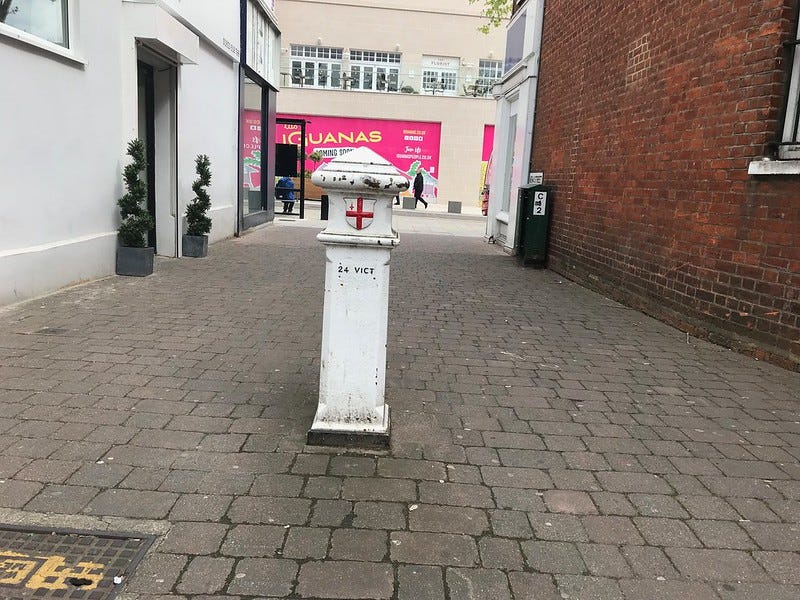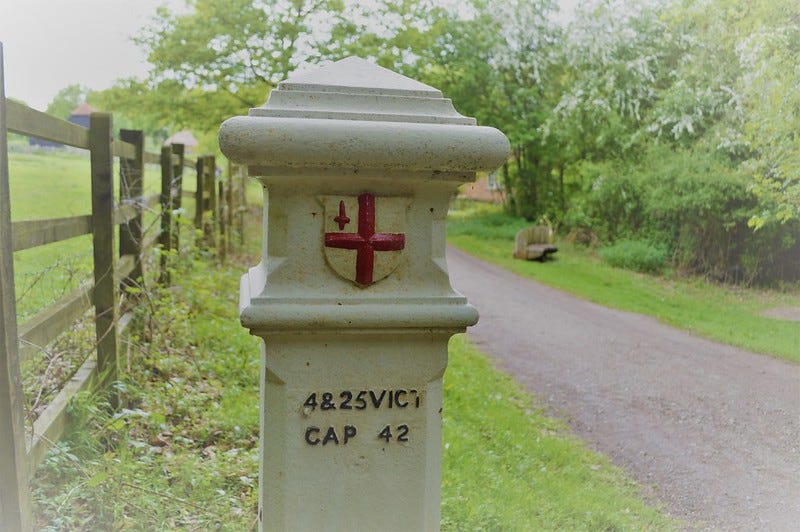Coal Tax Posts and Where to Find Them
They engirdle London and have a fascinating history.
Welcome to Londonist: Time Machine’s Friday newsletter for paying subscribers, with a generous teaser for everyone else.
Bollards, coal and tax. Not words to get many hearts racing, I’ll warrant. But this unpromising material leads into a fascinating London story. Today we’re out hunting a lesser-spotted species of street furniture on the periphery of the Big Smoke.
That’s for the mains section. First, the History Radar…
History Radar
Upcoming events of interest to London history fans.
👚 FASHION RENEGADES: Last chance to see… The Fashion & Textile Museum's Outlaws: Fashion Renegades of 80s London centres around legendary nightclub Taboo, opened by designer and performance artist Leigh Bowery in 1985, and looks at how its dress code and hedonistic philosophy influenced fashion. This is its final week.
👣 LITERARY FOOTPRINTS: Dickens, Mrs Dalloway, Rivers of London and Wolf Hall. Just some of the topics covered through walking tours and online events as part of Literary Footprints Festival this week. Expert guides from Footprints of London host the events. Until 31 March
✞ THE CANTERBURY TALES: The 4 March edition of The Conversation at St Martin-in-the-Fields features Professor of English Language and Literature at Oxford, Marion Turner, discussing Chaucer's Canterbury Tales, and what they tell us about power and prosperity and sex and society, as well as about London itself. After hearing from Turner, take part in a discussion on the topic with fellow attendees.
🏰 ELEANOR OF CASTILE: Historian Louise Wilkinson gives an online talk on 5 March about medieval queen Eleanor of Castile, wife of Edward I. Though she was known as a supportive partner, she had a more sinister side, as is revealed in this National Archives event.
🙋🏽♀️ INTERNATIONAL WOMEN'S DAY: Saturday 8 March is International Women's Day and March as a whole is Women's History Month, and both have busy events programmes. Some highlights are given on Londonist.com, but keep an eye out for lots more happening at various venues.
Coal Tax Posts and Where to Find Them
If you’ve ever wandered through the outer reaches of Greater London, then chances are you’ll have stumbled across one of these sturdy fellows.
More than 200 of these cast-iron sentinels form a ring around the capital. Each is about 1.2 metres high, painted white and emblazoned with the shield of the City of London. Not one of them is in the City of London, however.
Rather, the bollards engirdle the capital 20 miles out from the centre. You’ll find them at Uxbridge, Potters Bar, Dagenham, Caterham, and many places in-between.
If you hadn’t already guessed from my title, these are coal tax posts. They mark the frontier beyond which inbound coal merchants would have to pay tax to the City of London Corporation.
The system was scrapped over a century ago, but it does have parallels with the modern Ultra-Low Emission Zone (ULEZ). Here was a duty on a heavily polluting fuel, levied on anybody entering a clearly defined boundary far outside central London. Where it differed (apart from the lack of number-plate recognition technology) was that coal tax had no environmental purpose. It was simply to raise money for improvement works in the City of London.
“We built this city on rocks of coal…”
Today, so little coal is used domestically that Londoners scarcely think about the black stuff. Yet for hundreds of years this was the principal fuel for both heating and mechanical work (e.g. steam engines). Huge quantities were shipped to London annually, even before the Industrial Revolution. The city became known as the Big Smoke, thanks to all the coal it burned. All of it was taxed.
This wasn’t just a money grab. Coal tax played a crucial role in shaping London. After the Great Fire of 1666, St Paul’s Cathedral and many of the Wren churches were rebuilt largely with money from coal duties — the ultimate expression of fighting fire with fire. In a later age, the Victoria Embankment and wider sewer system were made possible by coal tax. The choky fuel thereby helped to end the Great Stink. This most hard-working of taxes also supported the building of Holborn Viaduct, New Oxford Street, and numerous other road improvements. London would look utterly different were it not for the tax on coal.
Until the Industrial Revolution, the carboniferous cargo was brought in to the Port of London exclusively by barge. Taxation was easy. Johnny Q. Collier could only tie up and offload his barge at a handful of dedicated quays. Tax inspectors would collect their dues and deposit them straight into the coffers of the City of London Corporation (or, in times of emergency, the national exchequer).
Then the canals came along, swiftly followed by the railways, and a more reliable road network. Suddenly, coal could make its sooty way into London via hundreds of different routes. Great for the coal supply, but a challenge for the customs men.

How to account for a commodity that could reach the region unseen by the inspectors? A load of old bollards. That’s how.



